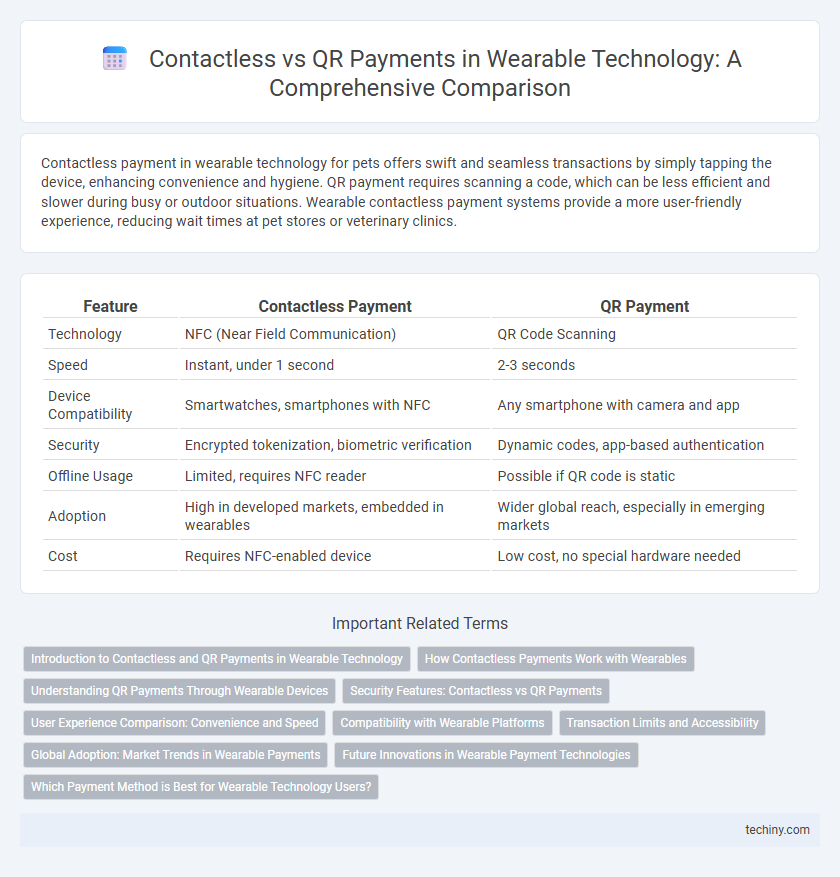Contactless payment in wearable technology for pets offers swift and seamless transactions by simply tapping the device, enhancing convenience and hygiene. QR payment requires scanning a code, which can be less efficient and slower during busy or outdoor situations. Wearable contactless payment systems provide a more user-friendly experience, reducing wait times at pet stores or veterinary clinics.
Table of Comparison
| Feature | Contactless Payment | QR Payment |
|---|---|---|
| Technology | NFC (Near Field Communication) | QR Code Scanning |
| Speed | Instant, under 1 second | 2-3 seconds |
| Device Compatibility | Smartwatches, smartphones with NFC | Any smartphone with camera and app |
| Security | Encrypted tokenization, biometric verification | Dynamic codes, app-based authentication |
| Offline Usage | Limited, requires NFC reader | Possible if QR code is static |
| Adoption | High in developed markets, embedded in wearables | Wider global reach, especially in emerging markets |
| Cost | Requires NFC-enabled device | Low cost, no special hardware needed |
Introduction to Contactless and QR Payments in Wearable Technology
Contactless payment in wearable technology utilizes NFC (Near Field Communication) to enable seamless and secure transactions by simply tapping the device near a payment terminal. QR payment integrates QR code scanning within smartwatches or fitness bands, allowing users to complete payments through camera recognition without physical contact. Both methods enhance convenience and safety in wearable commerce, with NFC providing faster transactions and QR codes offering broader compatibility across diverse merchant systems.
How Contactless Payments Work with Wearables
Contactless payments with wearables utilize Near Field Communication (NFC) technology, enabling secure transactions by simply tapping the device near a payment terminal. These devices store encrypted payment credentials, allowing instant authentication without revealing sensitive information. This seamless integration offers faster, more convenient payments compared to QR code scanning, which requires camera access and manual input.
Understanding QR Payments Through Wearable Devices
QR payments through wearable devices enable seamless and secure transactions by scanning QR codes directly from smartwatches or fitness bands, eliminating the need for physical cards or cash. Wearable devices equipped with QR code readers leverage near-field communication (NFC) and camera modules to facilitate fast payment authentication and data encryption. This technology enhances user convenience and expands digital payment accessibility, especially in environments where contactless card infrastructure is limited.
Security Features: Contactless vs QR Payments
Contactless payments leverage NFC technology with encrypted tokenization, significantly reducing the risk of data interception and fraud during transactions. QR payments rely on image scanning, which can be vulnerable to phishing attacks and counterfeit QR codes if users do not verify the source carefully. Advanced security protocols and biometric authentication integrated into wearable devices enhance protection in contactless payments compared to standard QR code methods.
User Experience Comparison: Convenience and Speed
Contactless payment through wearable technology offers unparalleled convenience by allowing users to complete transactions with a simple tap, significantly reducing checkout time. QR payments require users to unlock their devices and scan codes, introducing additional steps that can slow down the process. Wearables equipped with NFC technology streamline user experience by delivering faster, more seamless payments in everyday scenarios.
Compatibility with Wearable Platforms
Contactless payment technology seamlessly integrates with a wide range of wearable platforms through NFC-enabled devices, offering instant and secure transactions via smartwatches and fitness bands. In contrast, QR payment systems require camera access and app compatibility, which may limit their functionality on wearables lacking advanced imaging hardware. The prevailing trend favors NFC contactless payments for wearables due to their superior compatibility, user convenience, and growing acceptance across global payment networks.
Transaction Limits and Accessibility
Contactless payment through wearable technology typically offers higher transaction limits and faster processing times, enhancing convenience for everyday purchases and public transport. QR payment accessibility is broader due to smartphone compatibility and lower hardware requirements, but often comes with stricter transaction caps and slower transaction speeds. Both methods prioritize security, though contactless payments benefit from NFC encryption, ensuring safer high-value transactions in wearable devices.
Global Adoption: Market Trends in Wearable Payments
Contactless payment through wearable technology has seen rapid global adoption, with NFC-enabled devices leading markets in North America, Europe, and parts of Asia due to ease of use and strong infrastructure support. QR payment systems dominate in regions like China and Southeast Asia, driven by widespread smartphone adoption and low-cost implementation, facilitating mass-scale usage in everyday transactions. Market trends indicate a growing convergence as wearable devices integrate both NFC and QR capabilities, expanding consumer choice and payment flexibility worldwide.
Future Innovations in Wearable Payment Technologies
Wearable payment technologies are evolving beyond traditional contactless card emulation, integrating biometric authentication and blockchain for enhanced security and convenience. Future innovations are expected to merge QR code scanning with augmented reality interfaces, enabling users to initiate payments seamlessly through gesture control and holographic displays. Enhanced connectivity through 5G and AI-driven transaction verification will further accelerate adoption and optimize user experiences in wearable payment solutions.
Which Payment Method is Best for Wearable Technology Users?
Contactless payment offers seamless transactions with a simple tap, enhancing convenience and speed for wearable technology users, while QR payment requires scanning codes, which may add extra steps. Wearable devices equipped with NFC technology are better optimized for contactless payments, providing quicker and more secure experiences. For users prioritizing ease of use and efficiency, contactless payment remains the superior choice in wearable technology applications.
Contactless Payment vs QR Payment Infographic

 techiny.com
techiny.com